Chapter 10C. Signs, Illumination, and Markings
Section 10C.01 Purpose
Support:
Signs and markings regulate, warn, and guide the road users so that
they, as well as light rail transit vehicle operators, can take
appropriate action.
Standard:
The design and location of signs shall conform to Part
2.
Support:
Section 8B.02 contains
information regarding the sizes of signs for grade crossings.
Section 10C.02 Highway-Rail
Grade Crossing (Crossbuck) Sign (R15-1) and Number of Tracks Sign
(R15-2)
Standard:
The Highway-Rail Grade Crossing (R15-1) sign, commonly identified
as the Crossbuck sign, shall be retroreflectorized white with the
words RAILROAD CROSSING in black lettering, mounted as shown in
Figure 10C-1.
Figure
10C-1 Highway-Rail Grade Crossing (Crossbuck) Regulatory Signs
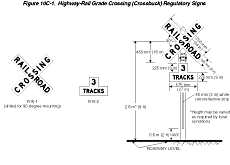
As a minimum, one Crossbuck sign shall be used
on each highway approach to every highway-light rail transit grade
crossing on a semiexclusive alignment, alone or in combination with
other traffic control devices.
Option:
A Crossbuck sign may be used on a higway approach to a highway-light
rail transit grade crossing on a mixed-use alignment, alone or in
combination with other traffic control devices.
Standard:
If automatic gates are not present where a Crossbuck sign is being
used and if there are two or more tracks at the highway-light rail
transit grade crossing, the number of tracks shall be indicated
on a supplemental Number of Tracks (R15-2) sign of inverted T shape
mounted below the Crossbuck sign in the manner and at the height
indicated in Figure 10C-1.
Option:
The supplemental Number of Tracks sign may also be used at highway-light
rail transit grade crossings with automatic gates.
Standard:
If used, the Crossbuck sign shall be installed on the right side
of the highway on each approach to the highway-light rail transit
grade crossing. Where restricted sight distance or unfavorable highway
geometry exists on an approach to a highway-light rail transit grade
crossing, an additional Crossbuck sign shall be installed on the
left side of the highway, possibly placed back-to-back with the
Crossbuck sign for the opposite approach, or otherwise located so
that two Crossbuck signs are displayed for that approach.
A strip of retroreflective white material not
less than 50 mm (2 in) in width shall be used on the back of each
blade of each Crossbuck sign for the length of each blade, at all
highway-light rail transit grade crossings, except those where Crossbuck
signs have been installed back-to-back.
A strip of retroreflective white material, not
less than 50 mm (2 in) in width, shall be used on each support at
passive highway-light rail transit grade crossings for the full
length of the front and back of the support from the Crossbuck sign
or Number of Tracks sign to within 0.6 m (2 ft) above the edge of
the roadway, except on the side of those supports where a STOP (R1-1)
or YIELD (R1-2) sign or flashing lights have been installed or on
the back side of supports for Crossbuck signs installed on one-way
streets.
Guidance:
If used, Crossbuck signs should be located with respect to the highway
pavement or shoulder in accordance with the criteria in Chapter
2A and Figures 2A-1
and 2A-2,
and should be located with respect to the nearest track in accordance
with Figure 8D-2.
The minimum lateral clearance for the nearest
edge of the Crossbuck sign should be 1.8 m (6 ft) from the edge
of the shoulder or 3.7 m (12 ft) from the edge of the traveled way
in rural areas, and 0.6 m (2 ft) from the face of the curb in urban
areas.
Where unusual conditions make variations in location
and lateral clearance appropriate, engineering judgment should be
used to provide the best practical combination of view and safety
clearances.
Section 10C.03 LOOK
Sign (R15-8)
Option:
A LOOK (for light rail transit vehicles) (R15-8) sign (see Figure
10C-2) may be mounted at highway-light rail transit grade crossings
as a supplemental plaque on the Crossbuck (R15-1) sign post, or
as a separate sign in the immediate vicinity of the highway-light
rail transit grade crossing on the light rail transit right-of-way.
Figure
10C-2 Regulatory Signs
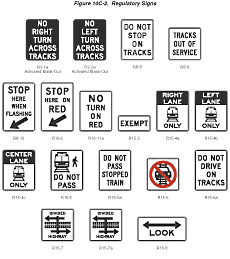
Section 10C.04 STOP
(R1-1) or YIELD (R1-2) Signs at Highway-Light Rail Transit Grade
Crossings
Standard:
For all highway-light rail transit grade crossings where STOP (R1-1)
or YIELD (R1-2) signs are installed, the placement shall conform
to the requirements of Sections 2B.06
and 2B.10.
Stop Ahead (W3-1) or Yield Ahead (W3-2) Advance Warning signs (see
Figure 2C-4) shall also
be installed if the criteria for their installation given in Section
2C.29 is met.
Guidance:
The use of STOP or YIELD signs for road users at highway-light rail
transit grade crossings should be limited to those crossings where
the need and feasibility is established by an engineering study.
Such crossings should have all of the following characteristics:
- The crossing roadways should be secondary in
character (such as a minor street with one lane in each direction,
an alley, or a driveway) with low traffic volumes and low speed
limits. The specific thresholds of traffic volumes and speed limits
should be determined by the local agencies.
- Light rail transit speeds do not exceed 40
km/h (25 mph).
- The line of sight for an approaching light
rail transit operator is adequate from a sufficient distance such
that the operator can sound an audible signal and bring the light
rail transit vehicle to a stop before arriving at the crossing.
- The road user has sufficient sight distance
at the stop line to permit the vehicle to cross the tracks before
the arrival of the light rail transit vehicle.
- If at an intersection of two roadways, the
intersection does not meet the warrants for a traffic control
signal as specified in Chapter 4C.
- The light rail transit tracks are located such
that vehicles are not likely to stop on the tracks while waiting
to enter a cross street or highway.
If a STOP or YIELD sign is installed beyond the
light rail transit crossing such that vehicle queues are likely
to extend into the path of the light rail transit, a DO NOT STOP
ON TRACKS sign (R8-8) should be posted in accordance with Section
10C.05.
Option:
If a STOP or YIELD sign is installed at a highway-light rail transit
grade crossing, it may be installed on the Crossbuck post or on
a separate post at the point where the vehicle is to stop, or as
near to that point as practical.
Section 10C.05 DO
NOT STOP ON TRACKS Sign (R8-8)
Guidance:
A DO NOT STOP ON TRACKS (R8-8) sign (see Figure
10C-2) should be installed whenever an engineering study determines
that the potential for vehicles stopping on the tracks at a highway-light
rail transit grade crossing is significant. Placement of the R8-8
sign should be determined as part of the engineering study. The
sign, if used, should be located on the right side of the highway
on either the near or far side of the grade crossing, depending
upon which position provides better visibility to approaching drivers.
Option:
DO NOT STOP ON TRACKS signs may be placed on both sides of the track.
On divided highways and one-way streets, a second
DO NOT STOP ON TRACKS sign may be placed on the near or far left
side of the highway-light rail transit at the grade crossing to
further improve visibility of the sign.
Section 10C.06 TRACKS
OUT OF SERVICE Sign (R8-9)
Option:
The TRACKS OUT OF SERVICE (R8-9) sign (see Figure 10C-2) may be
used at a highway-light rail transit grade crossing instead of a
Crossbuck (R15-1) sign and a Number of Tracks (R15-2) sign when
light rail transit tracks have been temporarily or permanently abandoned,
but only until such time that the tracks are removed or paved over.
Standard:
When tracks are out of service, traffic control devices and gate
arms shall be removed and the signal heads shall be removed or hooded
or turned from view to clearly indicate that they are not in operation.
The R8-9 sign shall be removed when the tracks
have been removed or covered or when the highway-light rail transit
grade crossing is returned to service.
Section 10C.07 STOP
HERE ON RED Sign (R10-6)
Support:
The STOP HERE ON RED (R10-6) sign (see Figure
10C-2) defines and facilitates observance of the stop lines
at traffic control signals.
Option:
A STOP HERE ON RED sign may be used at locations where vehicles
frequently violate the stop line or where it is not obvious to road
users where to stop.
Guidance:
If possible, stop lines should be placed at a point where the vehicle
driver has adequate sight distance along the track.
Section 10C.08 STOP
HERE WHEN FLASHING Sign (R8-10)
Option:
The STOP HERE WHEN FLASHING (R8-10) sign (see Figure 10C-2) may
be used at a highway-light rail transit grade crossing to inform
drivers of the location of the stop line or the point at which to
stop when the flashing-light signals (see Section
10D.02) are activated.
Section 10C.09 Light
Rail Transit-Activated Blank-Out Turn Prohibition Signs (R3-1a,
R3-2a)
Support:
Light rail transit operations can include the use of activated blank-out
sign technology for turn prohibition (R3-1a, R3-2a) signs (see Figure
10C-2). The signs are typically used on roads paralleling a
semiexclusive or mixed-use light rail transit alignment where road
users might turn across the light rail transit tracks. A blank-out
sign displays its message only when activated. When not activated,
the sign face is blank.
Guidance:
A light rail transit-activated blank-out turn prohibition sign should
be used where an intersection adjacent to a highway-light rail transit
crossing is controlled by STOP signs, or is controlled by traffic
control signals with permissive turn movements for road users crossing
the tracks.
Option:
A light rail transit-activated blank-out turn prohibition sign may
be used for turning movements that cross the tracks.
As an alternative to light rail transit-activated
blank-out turn prohibition signs at intersections with traffic control
signals, exclusive traffic control signal phases such that all movements
that cross the tracks have a red indication may be used in combination
with NO TURN ON RED (R10-11a) signs.
Standard:
Turn prohibition signs that are associated with preemption shall
be visible only when the highway-light rail transit grade crossing
restriction is in effect.
Section 10C.10 EXEMPT
Highway-Rail Grade Crossing Signs (R15-3, W10-1a)
Option:
When authorized by law or regulation, a supplemental EXEMPT (R15-3)
sign (see Figure 10C-2) with a white background may be used below
the Crossbuck sign or Number of Tracks sign, if present, at the
highway-light rail transit grade crossing, and a supplemental EXEMPT
(W10-1a) sign (see Figure 10C-3) with
a yellow background may be used below the Highway-Rail Advance Warning
(W10-1) sign. Where neither the Crossbuck nor the advance warning
signs exist for a particular crossing, an EXEMPT (R15-3) sign with
a white background may be placed on its own post on the near right
side of the approach to the crossing.
Support:
These supplemental signs inform drivers of vehicles carrying passengers
for hire, school buses carrying students, or vehicles carrying hazardous
materials that a stop is not required at certain designated highway-light
rail transit grade crossings, except when a light rail transit vehicle
is approaching or occupying the highway-light rail transit grade
crossing, or the driver's view is blocked.
Section 10C.11 Divided
Highway with Light Rail Transit Crossing Signs (R15-7 Series)
Option:
The Divided Highway With Light Rail Transit Crossing (R15-7) sign
(see Figure 10C-2) may be used as a supplemental sign on the approach
legs of a roadway that intersects with a divided highway where light
rail transit vehicles operate in the median. The sign may be placed
beneath a STOP sign or mounted separately.
Guidance:
The number of tracks shown on the R15-7 sign should be the same
as the actual number of tracks.
Standard:
When the Divided Highway With Light Rail Transit Crossing sign is
used at a four-legged intersection, the R15-7 sign shall be used.
When used at a T-intersection, the R15-7a sign shall be used.
Section 10C.12 No
Vehicles On Tracks Signs (R15-6, R15-6a)
Support:
The No Vehicles On Tracks (R15-6) sign (see
Figure 10C-2) is used where there are adjacent traffic lanes
separated from the light rail transit lane by a curb or pavement
markings.
Guidance:
The DO NOT ENTER (R5-1) sign should be used where a road user could
wrongly enter a light rail transit only street.
Option:
A No Vehicles On Tracks sign may be used to deter vehicles from
driving on the trackway. It may be installed either on a 0.9 m (3
ft) flexible post between double tracks, on a post alongside the
tracks, or overhead.
Instead of the R15-6 symbol sign, a regulatory sign
with the word message DO NOT DRIVE ON TRACKS (R15-6a) may be used
(see Figure 10C-2).
A reduced size of 300 x 300 mm (12 x 12 in) may
be used if the R15-6 sign is installed between double tracks.
Standard:
The smallest size for the R15-6 sign shall be 300 x 300 mm (12 x
12 in).
Section 10C.13 Light
Rail Transit Only Lane Signs (R15-4 Series)
Support:
The Light Rail Transit Only Lane (R15-4 series) signs (see Figure
10C-2) are used for multi-lane operations, where road users might
need additional guidance on lane use and/or restrictions.
Option:
Light Rail Transit Only Lane signs may be used on a roadway lane
limited to only light rail transit use to indicate the restricted
use of a lane in semiexclusive and mixed alignments.
Guidance:
If used, the R15-4a, R15-4b, and R15-4c signs should be installed
on posts adjacent to the roadway containing the light rail transit
tracks or overhead above the light rail transit only lane.
Option:
If the trackway is paved, preferential lane markings (see Section
3B.22) may be installed but only in combination with light rail
transit only lane signs.
Support:
The trackway is the continuous way designated for light rail transit,
including the entire dynamic envelope. Section
10C.25 contains more information regarding the dynamic envelope.
Section 10C.14 Do
Not Pass Light Rail Transit Signs (R15-5, R15-5a)
Support:
A Do Not Pass Light Rail Transit (R15-5) sign (see Figure 10C-2)
is used to indicate that vehicles are not allowed to pass light
rail transit vehicles that are loading or unloading passengers where
there is no raised platform or physical separation from the lanes
upon which other motor vehicles are operating.
Option:
The R15-5 sign may be used in mixed-use alignments and may be mounted
overhead where there are multiple lanes.
Instead of the R15-5 symbol sign, a regulatory sign
with the word message DO NOT PASS STOPPED TRAIN (R15-5a) may be
used (see Figure 10C-2).
Guidance:
If used, the R15-5 sign should be located immediately before the
light rail transit boarding area.
Section 10C.15 Highway-Rail
Grade Crossing Advance Warning Signs (W10 Series)
Standard:
A Highway-Rail Grade Crossing Advance Warning (W10-1) sign (see
Figure 10C-3) shall be used on each highway in advance of every
highway-light rail transit grade crossing in semiexclusive alignments
except in the following circumstances:
- On an approach to a highway-light rail transit
grade crossing from a T-intersection with a parallel highway,
if the distance from the edge of the track to the edge of the
parallel roadway is less than 30 m (100 ft), and W10-3 signs are
used on both approaches of the parallel highway; or
- On low-volume, low-speed highways crossing
minor spurs or other tracks that are infrequently used and are
flagged by transit crews; or
- In business districts where active highway-light
rail transit grade crossing traffic control devices are in use;
or
- Where physical conditions do not permit even
a partially effective display of the sign.
Figure
10C-3 Warning Signs and Light Rail Station Sign
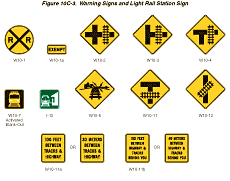
Placement of the Highway-Rail Grade Crossing Advance
Warning sign shall be in accordance with Chapter
2A and Table 2C-4.
Option:
On divided highways and one-way streets, an additional W10-1 sign
may be installed on the left side of the roadway.
Standard:
If the distance between the light rail transit tracks in a semiexclusive
alignment and a parallel highway, from the edge of the tracks to
the edge of the parallel roadway, is less than 30 m (100 ft), W10-2,
W10-3, or W10-4 signs (see Figure 10C-3) shall be installed on each
approach of the parallel highway to warn road users making a turn
that they will encounter a highway-light rail transit grade crossing
soon after making a turn, and a W10-1 sign for the approach to the
tracks shall not be required to be between the tracks and the parallel
highway.
If the W10-2, W10-3, or W10-4 signs are used,
sign placement in accordance with the guidelines for Intersection
Warning signs in Table 2C-4 using the speed of through traffic shall
be measured from the highway intersection.
Guidance:
If the distance between the light rail transit tracks and the parallel
highway, from the edge of the tracks to the edge of the parallel
roadway, is 30 m (100 ft) or more, a W10-1 sign should be installed
in advance of the highway-light rail transit grade crossing, and
the W10-2, W10-3, or W10-4 signs should not be used on the parallel
highway.
Section 10C.16 Low
Ground Clearance Highway-Rail Grade Crossing Sign (W10-5)
Guidance:
If the highway profile conditions are sufficiently abrupt to create
a hang-up situation for long wheelbase vehicles or for trailers
with low ground clearance, the Low Ground Clearance Highway-Rail
Grade Crossing (W10-5) sign (see Figure 10C-3)
should be installed in advance of the highway-light rail transit
grade crossing.
Support:
Information regarding the use of the W10-5 sign is contained in
Section 8B.17.
Section 10C.17 Light
Rail Transit Approaching-Activated Blank-Out Warning Sign (W10-7)
Support:
The Light Rail Transit Approaching-Activated Blank-Out (W10-7) warning
sign (see Figure 10C-3) supplements the traffic control signal to
warn road users turning across the tracks of an approaching parallel
light rail transit vehicle.
Option:
A Light Rail Transit Approaching-Activated Blank-Out warning sign
may be used at signalized intersections near grade crossings or
at crossings controlled by STOP signs or automatic gates.
Section 10C.18 Storage
Space Signs (W10-11, W10-11a, W10-11b)
Guidance:
A Storage Space (W10-11) sign supplemented by a word message storage
distance (W10-11a) sign (see Figure 10C-3) should be used where
there is a highway intersection in close proximity to the highway-light
rail transit grade crossing and an engineering study determines
that adequate space is not available to store a design vehicle(s)
between the highway intersection and the light rail transit vehicle
dynamic envelope.
Support:
Information regarding the use of the W10-11, W10-11a, and W10-11b
signs is contained in Section
8B.18.
Section 10C.19 Skewed
Crossing Sign (W10-12)
Option:
The Skewed Crossing (W10-12) sign (see Figure 10C-3) may be used
at a skewed highway-light rail transit grade crossing to warn drivers
that the light rail transit tracks are not perpendicular to the
highway.
Support:
Information regarding the use of the W10-12 sign is contained in
Section 8B.19.
Section 10C.20 Light
Rail Transit Station Sign (I-12)
Option:
The Light Rail Transit Station (I-12) sign (see Figure
10C-3) may be used to direct road users to a light rail transit
station or boarding location. It may be supplemented by the name
of the transit system and by arrows as provided in Section
2D.08.
Section 10C.21 Emergency
Notification Sign (I-13 or I-13a)
Guidance:
An Emergency Notification (I-13 or I-13a) sign (see Figure 10C-4)
should be installed at all highway-light rail transit grade crossings
on semiexclusive alignments to provide for emergency notification.
The sign should have a white message on blue background.
Location and placement should be decided cooperatively
by the transit company and the public or private highway agencies
based on specific site conditions.
This sign, which is for emergency notification,
should convey a clear and simple message that is visible to anyone
stalled or disabled on the transit tracks, and to anyone with other
emergencies.
Support:
Examples of sign messages are shown in Figure 10C-4.
Figure
10C-4 Emergency Notification Signs
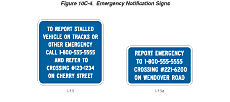
Section 10C.22 Illumination
at Highway-Light Rail Transit Crossings
Guidance:
Where light rail transit operations are conducted at night, illumination
at and adjacent to the highway-light rail transit grade crossing
should be considered.
Support:
Recommended types and location of luminaires for highway-rail (light
rail transit) grade crossings are contained in the American National
Standards Institute’s (ANSI) "Practice for Roadway Lighting
RP-8," available from the Illuminating Engineering Society
(see Section 1A.11).
Section 10C.23 Pavement
Markings
Standard:
All highway-light rail transit grade crossing pavement markings
shall be retroreflectorized white. All other markings shall be in
accordance with Part 3.
Pavement markings in advance of a highway-light
rail transit grade crossing shall consist of an X, the letters RR,
a no-passing marking (two-lane highways where centerline markings
are used), and certain transverse lines as shown in Figures 10C-5
and 10C-6.
Figure
10C-5 Example of Placement of Warning Signs and Pavement Markings
at Highway-Light Rail Transit Grade Crossings
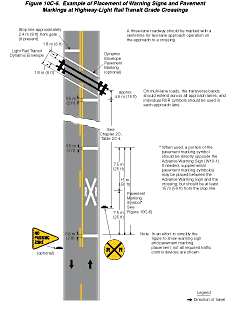
Figure
10C-6 Examples of Highway-Light Rail Transit Grade Crossing
Pavement Markings
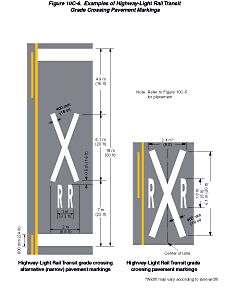
Identical markings shall be placed in each approach
lane on all paved approaches to highway-light rail transit grade
crossings where signals or automatic gates are located, and at all
other highway-light rail transit grade crossings where the posted
or statutory highway speed is 60 km/h (40 mph) or greater.
Pavement markings shall not be required at highway-light
rail transit grade crossings where the posted or statutory highway
speed is less than 60 km/h (40 mph), or in urban areas, if an engineering
study indicates that other installed devices provide suitable warning
and control.
Guidance:
When pavement markings are used, a portion of the X symbol should
be directly opposite the Advance Warning sign. The X symbol and
letters should be elongated to allow for the low angle at which
they will be viewed.
Option:
When justified by engineering judgment, supplemental pavement marking
symbol(s) may be placed between the Advance Warning sign and the
highway-light rail transit grade crossing.
Section 10C.24 Stop
Lines
Support:
Information regarding the use of stop lines at grade crossings is
contained in Section 8B.21.
Section 10C.25 Dynamic
Envelope Markings
Support:
The dynamic envelope (see Figure 10C-7) markings indicate the clearance
required for the light rail transit vehicle overhang resulting from
any combination of loading, lateral motion, or suspension failure.
Figure
10C-7 Light Rail Transit Vehicle Dynamic Envelope
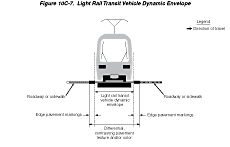
Option:
The dynamic envelope may be delineated on the pavement using pavement
markings (see Figures 10C-8 and 10C-9) or contrasting pavement color
and/or contrasting pavement texture (see Figure 10C-10).
Figure
10C-8 Typical Light Rail Transit Vehicle Dynamic Envelope Pavement
Markings
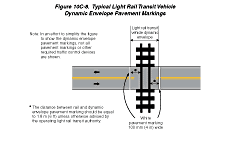
Figure
10C-9 Example of Light Rail Transit Vehicle Dynamic Envelope
Pavement Markings
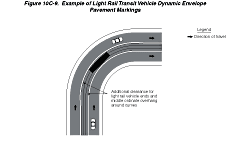
Figure
10C-10 Example of Light Rail Transit Vehicle Dynamic Envelope
Contrasting Color and/or Texture
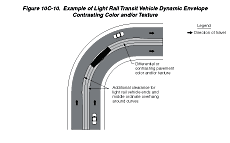
Standard:
If used, pavement markings for indicating the dynamic envelope shall
conform to Part 3 and shall be a 100 mm (4 in) normal solid white
line or contrasting pavement color and/or contrasting pavement texture.
Guidance:
If pavement markings are used to convey the dynamic envelope, they
should be placed completely outside of the dynamic envelope. If
used at light-rail transit grade crossings, dynamic envelope pavement
markings should be placed on the highway 1.8 m (6 ft) from the nearest
rail and installed parallel to the tracks, unless the transit authority
and/or operating company advises otherwise. The pavement markings
should extend across the roadway as shown in Figure
10C-8.
Option:
In semiexclusive alignments, the dynamic envelope markings may be
along the light rail transit trackway between intersections where
the trackway is immediately adjacent to travel lanes and no physical
barrier is present.
In mixed-use alignments the dynamic envelope markings
may be continuous between intersections.
Dynamic envelope markings may be installed at all
highway-light rail transit grade crossings, unless a Four-Quadrant
Gate system (see Section 10D.04)
is used.
Pavement markings for adjacent travel or parking
lanes may be used instead of dynamic envelope markings if the lines
are outside the dynamic envelope.
Back to Top
|

